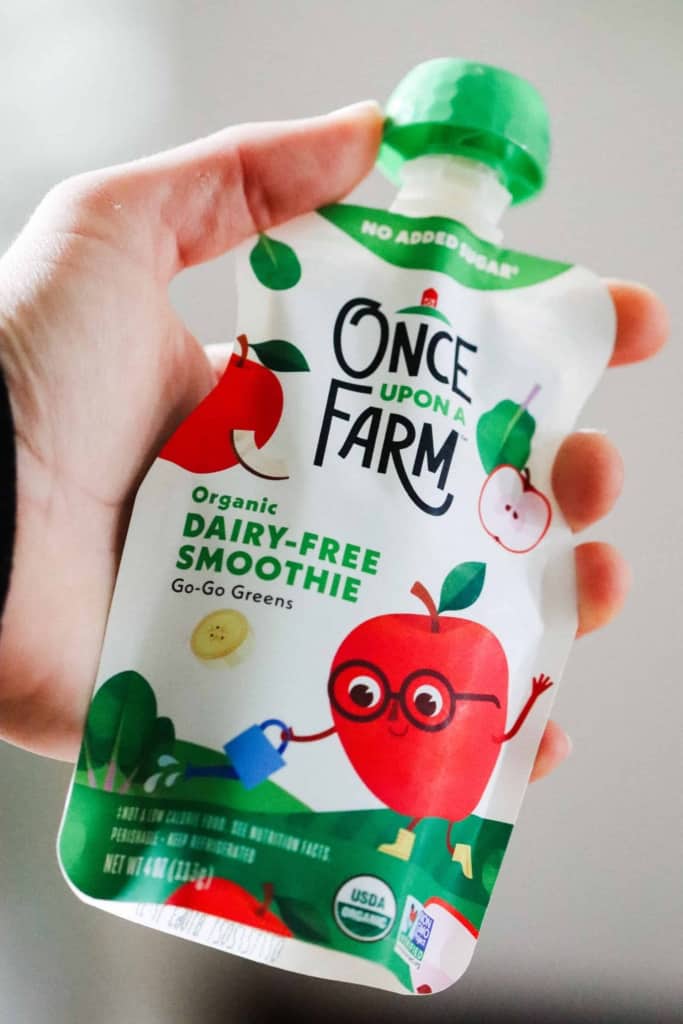What Healthy Snacking Should Look Like for Babies and Kids
Jun 03, 2021, Updated Nov 08, 2023
This post contains affiliate links. Please see our disclosure policy.
This post is sponsored by Once Upon a Farm, but as always, all opinions are my own.
Discover how to easily build a healthy snacking routine by keeping these staple foods in your pantry and fridge!
Snacking is kind of a whole new world, after you’re used to keeping track of bottles and/or nursing sessions.
Something that a close mom friend told me when my oldest was a baby that I’ll never forget — everything is a phase. Whether it’s good or bad, it’s a phase. Things are always changing when you have a baby or young kids. It can be hard to roll with it all though, and know what is best for your little one at each stage.
Let’s talk about where to even begin with snacks, and which healthy foods to keep on hand for a great snacking routine.
What age should babies and toddlers start snacking?
Age 1 is a great time to start incorporating snacks, as bottles and/or breastmilk start to decrease. But this is not a hard and fast rule, of course. If you feel like, how can I possibly fit another feeding opportunity in right now? Then don’t feel pressure to add snacks in just yet.
Usually when you start dropping midday feeds, you’ll want to replace those with a snack. So for example, if they are eating 3 meals a day and also getting breastmilk/formula before their morning and afternoon naps, when you phase out one or both of those feedings, a snack can go in its place.
How many snacks a day should a one year old have?
Okay I know this answer is universally disliked, but it depends. Anywhere from 0 to 3 can be appropriate, depending on their schedule. Let’s talk through some different scenarios so you can figure out which applies to you.
- 0 snacks:
- Your one year old is nursing on demand, or you have not yet dropped midday feedings. Your little one is drinking breastmilk/formula or eating every 2-3 hours during the day.
- It is not recommended to add snacks if they are still filling up on breastmilk and/or formula in between meals — this milk counts as a snack, technically!
- 1 snack:
- Length and frequency of nursing sessions has dropped, or you are only offering 1 bottle midday. (You may still be offering a morning and bedtime bottle/nursing.)
- This may look something like:
- 6:30am: bottle/breast
- 7am: breakfast
- 9am: snack
- Morning nap
- 11:30am: lunch
- 2pm: bottle/breast
- Afternoon nap
- 5pm: dinner
- 6:30pm: bottle/breast
- 2 snacks:
- Little one is only doing a morning and/or bedtime bottle at most. They may have dropped bottles completely, and may have weaned.
- Usually 2 snacks is where most toddlers can stay. Their schedule will have breakfast, lunch, and dinner, with a mid-morning snack and a mid-afternoon snack. This is what it will look like when they are 2, 3, and 4 years old, too.
- 3 snacks:
- Occasionally toddlers will also have a bedtime snack in the routine. This is usually necessary if the toddler has 2+ hours in between dinner and bedtime, or if they tend to not make it through the night unless they have something before bed.
How do I know if a snack is a healthy option for my little one?
Now that we’ve covered the when and how often of snacking, what should you actually give them?
While at meals I suggest incorporating all three macronutrients; protein, carbs, and fat, at snack time you get a little break, and should aim to offer two of the three.
So if you’re offering something from a package, you should find at least 2g protein in addition to carbohydrates. Or be on the lookout for healthy fats, like nuts or seeds, for example. And if you find products that do have all three macronutrients, that’s excellent! It’s just typically harder to find in snack items.
Added Sugar
For babies and toddlers under 2, it’s important to limit added sugars. We want to get as much nutrition in as possible during this critical growth and development stage. And while sugar tastes good, it doesn’t offer much nutrition.
You’re not going to be able to avoid it completely, but aim to serve items that have less than 5g added sugars, and ideally, you’ll find some options that are completely added sugar free, too. I’ll give you ideas next!
What are the best staple foods to keep in the pantry and fridge for snacks?
Refrigerator

If you want to make things as simple as possible, keep a handful of Once Upon a Farm dairy free smoothies and Fruit & Veggie blends in the fridge each week. These surpass all of my nutrition criteria for a snack! And they make it easy on you when the thought of making food AGAIN is beyond unappealing.
They are made with plant-based, nutrient dense ingredients, and have enough protein and healthy fats to keep your little one satisfied until the next mealtime. I’m also a fan of keeping them stocked in my fridge because:
- They contain No Added Sugar
- They’re refrigerated, USDA Organic, Non-GMO Project Verified
- Made with whole fruits and veggies
- Cold-pressed protected to lock in the nutrients, flavors and texture of ingredients while keeping the blends safe for your little ones
Honestly if I were to create my own smoothie pouches, I would make them exactly the same as Once Upon a Farm. They hit the nail on the head with excellent toddler nutrition in kid-friendly flavors.

What else is great to have on hand in the fridge for snacks?
- Fruit, of course! All fruit is nutritious, don’t let the carb-haters tell you otherwise. Some great ways to pair fruit with protein or healthy fats:
- Nut butter or sunflower seed butter
- Thin it out with a little yogurt and sprinkle in cinnamon to make a great easy fruit dip! This goes great with:
- Bananas
- Thin apple slices
- Pears
- Strawberries
- Thin it out with a little yogurt and sprinkle in cinnamon to make a great easy fruit dip! This goes great with:
- Cottage cheese
- This pairs so well with:
- grapes (green or red, be sure to slice lengthwise for choking safety)
- pineapple sticks
- Apple slices
- Applesauce
- Melon
- This pairs so well with:
- Nut butter or sunflower seed butter
- Veggies
- Veggies pair great with nut butter, too. For toddlers, I would let them dip thin slices of:
- Carrot
- Red pepper
- Seedless cucumber
- Zucchini (yes it can be eaten raw!)
- Olive oil and balsamic dip – it’s very fun for them to see the oil and vinegar together, and how they don’t mix! Olive oil is a great healthy fat for dipping. In addition to the veggies above, you can also try:
- Romaine lettuce pieces
- Tomato slices
- Broccoli
- Cauliflower
- Veggies pair great with nut butter, too. For toddlers, I would let them dip thin slices of:
Pantry
- Almond flour crackers- for added protein
- Whole wheat crackers- for fiber
- Thin rice cakes- great for spreading on avocado and some hemp seeds!
- Plain instant oatmeal- quick to make and great to mix with a teaspoon or two of nut or seed butter
- Chia seeds- add them as “sprinkles” to foods like yogurt, oatmeal, or even applesauce for a healthy fat boost
- Freeze dried fruit- if they love crunchy things! Pair it with something like cheese, a yogurt, or even some edamame or beans to complete the snack
How much should they eat at snack time?
You’ll want snacks to be at least about 90-100 calories. If it’s only 40-50, it won’t satisfy them for very long!
It’s okay not to give unlimited portions at snack time, especially with foods that you know aren’t even that filling (like pretzels or chips). The purpose of the snack is to be sort of a “mini meal” to give them more calories in between meals. It does not need to be as filling as a meal.
What are your favorite healthy items to keep on hand for snacks?
Let me know in the comments!














Frozen peas are a great snack with the added bonus of feeling good on your baby’s gums.